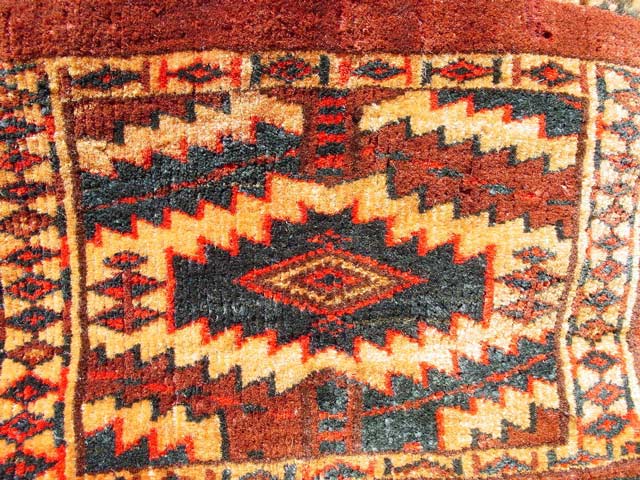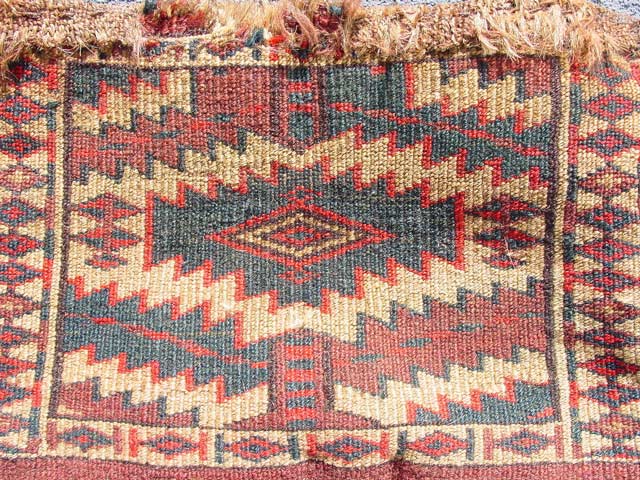Posted by Patrick Weiler on 03-03-2002 11:23 AM:
Now We're Smokin'
Where There's Smoke,
The small Yomud mafrash shown below has what I have learned to call a "smoked" appearance. The "ivory"
wool is a deep tawny color.

From the back it is somewhat less deep, but nonetheless a rather dark as opposed to a sparkling white.

I do not drive about the countryside looking for sheep, so I am not certain that this would NOT be a natural wool
color, but Salon picture #9, with the cotton whites and ivory wool shows the wool as approximately the same color
as the tawny white in my little mafrash. Many Yomut rugs show well-defined, crisp white wool, though. The first
photo in the salon (also #26) shows a Chodor fragment with a dark "white" in the upper border that looks
"smokey", too.
Most rug books with Turkmen weavings show numerous examples of this tawny colored wool right next to other examples
with "pure" whites.
Is this an effect caused by exposure to smoke? Why aren't more rugs this color if environmental smoke causes this
appearance?
It certainly does not clean up and whiten to any extent when washed in Orvus for a day. It was suggested to use
Baking Soda to lighten it up. Any comments on that?
The flatweave back to this piece is an even darker khaki color, so it was either this color when woven, or something
has caused it to become "smoked".
Does cotton retain a whiter appearance when subjected to the "smoke" that caused this deep color, and
could that have been a reason for the weavers to have used cotton often in these weavings which would have been
subjected to so much smoke in their daily lives?
Are the sheep out there in the field smoking late at night 
Patrick Weiler
Posted by Steve Price on 03-03-2002 12:42 PM:
Hi Patrick,
I doubt that the uneven tawny color of the nominally ivory wool on that piece is a result of exposure to smoke.
Smoke stains (at least all the smoke stains I've seen) are gray, not yellow-brown. I would also expect smoke staining
to be fairly uniform over small areas, especially if the staining occurred gradually from the piece being in a
tent with an open fire in the middle of it.
We had a Salon awhile back in which the topic was stray reds, and my suspicion is that the tawny color on pieces
like yours, like the stray reds that are not color runs, is on the wool before it is woven. Perhaps some wool is
that color to begin with. I haven't seen a whole lot of wild sheep up close, but I believe the colors of the wool
are often uneven rather than uniform.
Regards,
Steve Price
Posted by Marvin Amstey on 03-03-2002 01:22 PM:
Another possibilty: I once had a Yomud main carpet with irregular
tawny-yellowish whites in an otherwise pristine white border. A few dealers had the opinion that this was purposeful
to dull the otherwise very bright white wool to make it look older and more acceptable to 1920's American decorating.
The whites were toned "down" much as the new "tea-stained" rugs from India. Same thing was
done to new, bright Saruks, Kashans and others by bleaching and then redyeing (painting). One dealer bought the
rug on the condition that he could remove the stain. He did, and then I was sorry to have sold it since it looked
teriffic.
Regards,
Marvin
Posted by Patrick Weiler on 03-03-2002 03:44 PM:
Marvin,
You don't suppose there are unscrupulous rug dealers that would tea-stain a newer weaving to make it look older,
do you? 
Nah!
Patrick Weiler
Posted by Marla Mallett on 03-04-2002 06:16 PM:
Can't say about dealers and special washes....But for one important
museum exhibition of Anatolian kilims a short while back a conscious decision was made to NOT wash the kilims,
for fear that their brilliant white cottons would lend the pieces too “new” a look. So several were photographed
and displayed caked with mud! Then shown in the dark.
Best,
Marla
Posted by Marvin Amstey on 03-05-2002 10:54 AM:
We're those curators alive and well during the 20's and 30's?
That certainly was the same behavior then. Why are people afraid of what was made?
Regards,
Marvin
Posted by Patrick Weiler on 03-06-2002 12:59 AM:
Wild Sheep?
Steve,
You say you have not seen a lot of wild sheep up close. Is there any such thing as a "wild sheep" that
is not extinct? I thought sheep were domesticated several thousand years ago.  I know that you have been interested in oriental rugs for quite
some time, but I was unaware of your true age....
I know that you have been interested in oriental rugs for quite
some time, but I was unaware of your true age.... ?
?
Patrick Weiler
Posted by Steve Price on 03-06-2002 06:14 AM:
Hi Patrick,
I guess the fact that they're extinct accounts for my not having seen any wild sheep up close recently. I was beginning
to wonder where they all went.

Steve Price
Posted by Patrick Weiler on 03-06-2002 09:32 PM:
Wild Sheep Spotted !
Steve,
There are actually 4 species of wild sheep remaining in the world today, including the Bighorn of North America
(not what you would consider a good rug-wool sheep). There are wild sheep in the Urals and Mongolia. I would not
recommend shearing them and using their wool in a rug, though. It would be like milking a mountain goat.
The link here shows that sheep have been domesticated for their wool for many thousands of years.
http://www.woolmark.com/twc/sheep01.htm
Gotta go chase down my flock!
Patrick Weiler
Posted by Steve Price on 03-06-2002 10:22 PM:
Hi Patrick,
Go look for your sheep. But remember, when you find them: NO ABOMINATIONS ALLOWED!
Regards,
Steve Price
Posted by R. John Howe on 03-07-2002 06:42 AM:
Dear folks -
If you want to read about sheep (domesticated varieties but with some good info on their sources) here is a nice
link:
http://www.ansi.okstate.edu/breeds/sheep/
And for those of us enamored of Turkmen weaving, the Karakul is of special interest.
http://www.karakulsheep.com/
Do be careful about pursuing this subject, though. Some fairly strange stuff comes up if you do a search for "sheep."
Regards,
R. John Howe
Posted by Sophia Gates on 03-07-2002 12:14 PM:
Back to the Smoke
I'm a little confused as to Steve's comments concerning smoke
stains - he says that the only smoke stains he's seen are gray.
Wouldn't that depend at least partially on the composition of the smoke? I've read accounts about the Turkmen holdings
in Russian museums; many of them seem to have a yellowish haze or tinge. And I've heard the term "smoky"
applied to many, many weavings with tawny "whites". And I'm curious also as to whether the smoke residues
might actually change some of the characteristics of the dyes themselves. Do they damage the wool? Can they alter
color altogether?
This is not to discount the possibility that some dealers have used tea stains to cool down bright whites. I think
that's probably been going on practically forever. It may partially be due to an aethestic judgement, just as a
painter would use a glaze to soften brights. But mostly it's probably because of BUYERS, to answer Marvin's question.
THAT'S what the sellers are afraid of! Buyers who won't buy if they think a piece is too new. Silly, huh?
Posted by Steve Price on 03-07-2002 12:43 PM:
Hi Sophia,
The only smoke stains I've seen are gray. Why? The smoke from most fires is gray, and I suppose that this is the
reason the stains it creates are usually that color. Another possible explanation is that my recollection is simply
wrong.
In a tent with food cooking in it, there could be all kinds of stuff in the air, and brownish deposits might very
well result from them. Animal fat, for instance, vaporizes when it gets hot and condenses on cool surfaces when
it gets to them. The deposit is usually brownish. Those aren't smoke stains, but it could explain tawny colors
on white wool that was kept in such a tent.
Either way, I'd expect the stains (smoke, grease or anything else airborne) to be on the outer surfaces of bags,
with little of it on the inside or near the bases of the knots.
Could the deposits from smoke or fat or anything else react with the wool? I guess so, but as a general rule, chemical
reactions don't proceed or proceed rather slowly when all the constituents are in the solid state. For this reason,
I'm inclined to doubt that smoke exposure does much beyond deposit its dingy looking self on the surface of wool.
Regards,
Steve Price
Posted by Jerry Silverman on 03-07-2002 04:05 PM:
Okay...enough idle speculation. Time for a response from an
expert with experimental data.
My wife and son smoke cigarettes, and I smoke a pipe pretty much continuously.
Every decade or so we repaint our home. Before we repaint we wash the walls. The rags get brown not gray. The water
in the bucket gets brown not gray.
Same thing for my monthly cleaning of my computer monitor (which gets a direct stream of pipe smoke all day long).
Brown residue on the cloth.
Maybe a wood fire produces a different color residue; I'm not an expert on that. But the residue on the walls around
our stove top (cooking grease, etc.) is also brownish.
Now it's back to creating more experimental data.
-Jerry-
Posted by Steve Price on 03-07-2002 04:24 PM:
Hi Jerry,
Tobacco smoking does, indeed, generate a brownish residue. This is the tars in the tobacco that are made volatile
by the high heat, but not actually burned. They stain things for pretty much the same reason animal fat that's
been made very hot stains things.
I don't know whether the central and western Asian tribal folk smoked tobacco in the 19th century - I suspect that
most did not. But most did have open fires in the tents, and cooked on them. My guess would be that the gray stains
we see on a few pieces are the result of smoke from the wood fires, and the brownish/yellowish discolorations are
from volatilized stuff from cooking foods.
All of this assumes, of course, that the discolorations were there before the pieces were taken out of the tribal
communities. That assumption may not be a very good one.
Regards,
Steve Price
All times are GMT -5 hours. The time now is 01:00 PM.
Powered by: vBulletin Version 2.2.1
Copyright © Jelsoft Enterprises Limited 2000, 2001.

